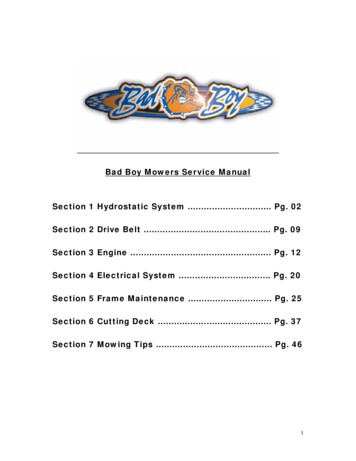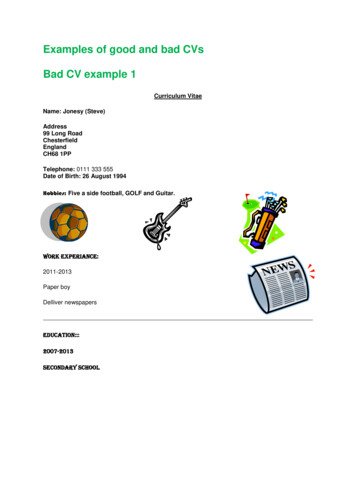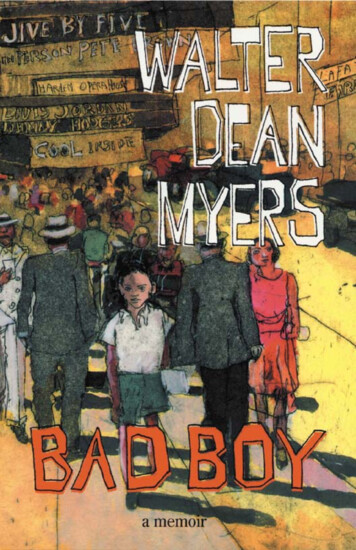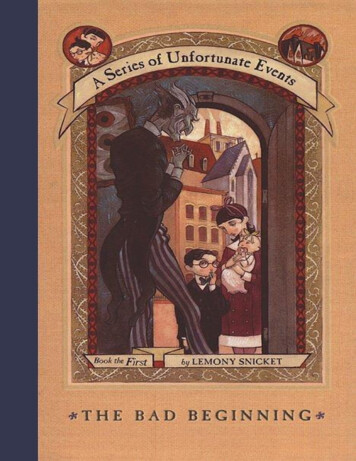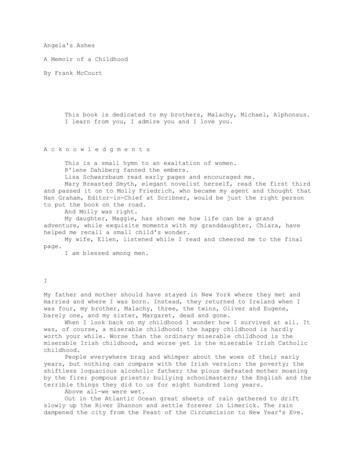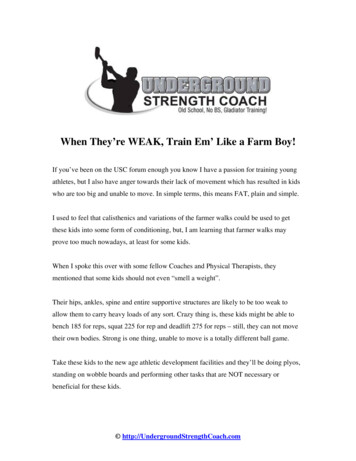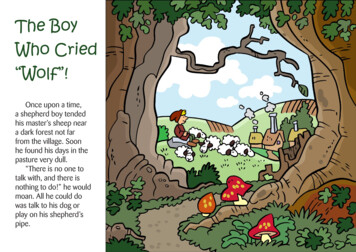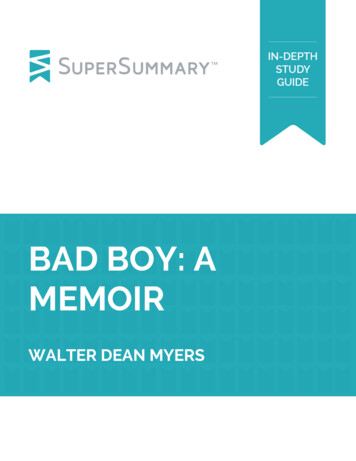
Transcription
BAD BOY: AMEMOIRWALTER DEAN MYERS
BAD BOYSUPERSUMMARY1TABLE OF CONTENTSPLOT OVERVIEW3CHAPTER SUMMARIES AND ANALYSES5Chapters 1-3Chapters 4-6Chapters 7-9Chapters 10-12Chapters 13-16Chapters 17-195812162126CHARACTER ANALYSIS31Walter Dean MyersFlorence Dean (“Mama”)Herbert Dean (“Dad”)Frank HallEric LeonhardtDr. HolidayEnglish and Writing TeacherMr. LasherMrs. FinleyMrs. ConwayWilliam Dean (“Pap”)Leroy Dean (“Uncle Lee”)George Myers Jr. (“Mickey”)Geraldine (“Gerry”) and ViolaMrs. Dodson and Dorothy DodsonNancy Dean (Aunt Nancy)Imogene Myers (“Jean”)George Myers313132333434353535363636373737383838COPYRIGHT 2018
BAD BOYSUPERSUMMARY2Mary Dolly Green38THEMES39SYMBOLS AND MOTIFS46IMPORTANT QUOTES49ESSAY TOPICS62COPYRIGHT 2018
BAD BOYSUPERSUMMARY3PLOT OVERVIEWBad Boy is a 2001 memoir spanning roughly the first seventeen years of YA writerWalter Dean Myers‖s life. In it, Myers explores how the time he spent growing up ina mixed-race, working-class family in 1940s-and-50s Harlem impacted his eventualcareer as a writer.To do so, Myers first explains his complicated family history: Myers‖s biologicalparents were both black, but he was adopted at a very young age by his father‖sfirst wife, Florence—a half-German, half-Native American woman who laterremarried a black man named Herbert Dean. Myers adored his adoptive parents,and fondly recalls how his mother instilled an early love of language in him byreading aloud to him in their “sun-drenched Harlem kitchen” (14).Despite his strong reading skills, Myers initially had trouble in school, largely thanksto a speech impediment that made him the target of bullying. In turn, Myers wouldlash out at his attackers and get into trouble himself. As he moved throughelementary school, however, teachers began to recognize his potential and takesteps to help him succeed by providing him with books to read, enrolling him inspeech-therapy classes, and eventually moving him to an accelerated class thatwould allow him to graduate early. Myers also benefited from the friendships hewas forming, not only with the local boys he played basketball with, but also withfellow students of different races and backgrounds.When Myers entered high school, however, his life slowly began to unravel. Forone, Myers‖s increasingly intellectual interests distanced him from his parents;Herbert couldn‖t read, and Florence didn‖t read the sorts of literature Myers wasnow enjoying or, increasingly, emulating in his own writing. At the same time,Myers felt out of place at Stuyvesant High because of the emphasis it placed onsending its students on to college; although Myers himself desperately wanted tocontinue his education, his family‖s financial situation was deteriorating, and herealized that he would likely not be able to do so. Most of all, Myers wasincreasingly aware of how being black limited his options in life. In fact, he was soused to a school curriculum centered on white authors that he came to see his ownblackness as an obstacle to his dreams of becoming a writer himself.As a result of all this, Myers grew deeply depressed and reverted to his earlier “badboy” habits; he skipped school frequently, got into neighborhood fights, and cuthimself off from virtually all his friends. The exception was Frank—a man with aCOPYRIGHT 2018
BAD BOYSUPERSUMMARY4history of blacking out and killing people. Although “mild-mannered” when in hisright senses, Frank led a dangerous life, picking up odd jobs delivering drugs (158).He was eventually forced to flee the city for his own safety, and Myers—who hadaccompanied him on several jobs—realized that he was in danger as well. Shortlyafter high school graduation (an event Myers missed entirely), Myers enlisted in theArmy.Bad Boy doesn‖t describe Myers‖s adult life in detail, instead skimming over theyears Myers spent in the military and in working various blue-collar jobs. Myersexplains, however, that the unthinking life he was living eventually becameintolerable, and that he turned back to writing as a result. Slowly, he began to seesome of his work published—particularly once he realized his experiences as ablack man were a potential source of creativity, not a roadblock to it. Myerseventually became a full-time writer and made his peace with his childhood, whichhe now considers “marvelous” (205). He writes that while his parents still don‖t fullyunderstand his career, they largely support him in it. Above all, Myers expresses hisgratitude for the “world” he now inhabits, which he says is full of “book lovers andpeople eager to rise to the music of language and ideas” (206).COPYRIGHT 2018
BAD BOYSUPERSUMMARY5CHAPTER SUMMARIES AND ANALYSESChapters 1-3Chapter 1 Summary: "Roots"Myers begins his memoir with an account of the world (and family) he was borninto, explaining that this backstory cannot be separated from his own experiences:"While we live our own individual lives, what has gone before us, our history,always has some effect on us" (1). In Myers's case, this history can be traced backto the era of slavery; his great-great-uncle, Lucas D. Dennis, worked on a plantationin what would later become West Virginia. After the Civil War, Dennis moved toMartinsburg, West Virginia, where his family "merged" with another family—theGreens—ultimately leading to the birth of Myers's mother, Mary Dolly Green (3).Molly, however, died while Myers himself was too young to remember her. What'smore, his family life was complicated by the fact that Molly was his father's, GeorgeMyers's, second wife. George‖s first wife, Florence, was the woman who actuallyraised Myers. Myers therefore details Florence's background as well, explainingthat her mother was a German immigrant who married a Native American man.However, while Florence herself was biracial, her family didn't approve of hermarriage to George Myers, which ended in divorce after the couple had twodaughters, Geraldine and Viola.Florence eventually remarried, this time to the man—Herbert Dean—who wouldbecome Myers‖s adoptive father. Herbert had declined to go into his own father'shauling business—and later left his hometown of Baltimore—to marry Florence:"The woman [ ] was white, and that posed a problem in Baltimore. Perhaps,Herbert thought, it would be less of a problem in New York" (5). The coupletherefore settled in Harlem, where they eventually brought Florence's daughters,Geraldine and Viola, to live with them. When they did, they also met the fivechildren George Myers had had with Mary, and soon adopted the youngest son—Myers himself—as well.Chapter 2 Summary: "Harlem"The first home Myers remembers clearly is Harlem, which he describes as a"magical place, alive with music that spilled onto the busy streets from tenementwindows and full of colors and smells that filled [his] senses" (7). In fact, some of hisCOPYRIGHT 2018
BAD BOYSUPERSUMMARY6earliest memories involve dancing in the street to music playing on radios; peoplewould toss pennies to him, and he used these, as well as the account Florenceopened for him at the local grocery, to buy treats like chocolate and ice pops. Hewould also spend time following Florence around the house as she did chores.Initially, Florence sometimes took work outside the home as a maid, but afterMyers got into a series of accidents—overindulging on popsicles; falling off a set ofclimbing bars at his babysitter's home—she decided to stay home and devote moreattention to her son. This pleased Myers, who was somewhat spoiled; on oneoccasion, for example, he deliberately broke a watch his parents had given hissister, Geraldine ("Gerry"). Florence responded by spanking him, and then begansending him to her sister-in-law, Nancy, during the work week.Although Nancy lived in a neighborhood with few other black people, Myers saysthat he was too young to be bothered by this at the time. However, the area washome to many Jewish families, and some of the boys who hung around his aunt‖sbakery persuaded Myers to join them in fights with the local Jewish boys.Although Myers generally liked Nancy‖s neighborhood, his favorite memories areof the time he spent with his mother, whether walking around town shopping orsimply listening to her read aloud from magazines: "The sound of Mama's voice inour sun-drenched Harlem kitchen was like a special kind of music, meant only forme" (14). Myers says he believes his mother was more open with him than withothers, recalling how she would sometimes yodel for him. In turn, Myers was eagerto impress Florence by learning to speak well and to read: "I liked words andtalking, and wanted to be able to look at the magazines and tell her the stories asshe did for me" (16).Chapter 3 Summary: "Let's Hear It for the First Grade!"When Myers was ready to begin school, a problem arose: his reading skills wereequivalent to a second-grader's, but he had a speech impediment, so his teacherrecommended that he not skip a grade. Still, Myers liked school on the whole, andonly got in trouble once his first year (for dumping glue on a boy‖s lap).Things changed in second grade, when students began to make fun of the wayMyers talked. Myers—who until then hadn‖t really noticed his speech problems—eventually snapped and punched one of his bullies, but being sent to the principaldidn't make much of an impression on him. His punishment—writing lines—alsoCOPYRIGHT 2018
BAD BOYSUPERSUMMARY7didn't have the intended effect: "I took a ruler and made a straight line down theleft-hand side of each page. That straight line was going to be my 'I' for each of thefive hundred times. But when I wrote out the first 'I will never, never ' I learned thatI couldn't fit the sentence on one line. Life was not fair" (20).Around this time, Myers explains, his family moved to a new apartment onMorningside Avenue—a "wide and beautiful" street (20). Although initially designedas a one-bedroom apartment, the new home seemed large and luxurious to theDeans. Much to Myers's delight, his mother entrusted him with a key to the newapartment so that he could let himself in after school (Herbert had been draftedinto the Navy when the U.S. entered World War II, and Florence and Myers‖s sisterswere working outside the home). Unbeknownst to Florence, Myers used his key tosneak comic books discarded by a next-door neighbor into his bedroom.Despite Myers's love of reading, things were not going well in school or speechtherapy: "The trouble was that to me, the words seemed clear. I found it frustratingwhen a teacher would ask me to repeat a phrase over and over, or when a teachersaid that I did not know a word because I did not pronounce it correctly" (25).Myers's sensitivity over his speech contributed to his conduct problems, whicheventually caused his third-grade teacher to fail him in most subjects. He wasallowed to proceed to fourth grade, but Florence spanked him and told him hewould need to study over the summer.Chapters 1-3 AnalysisOne of the most prominent themes in Bad Boy is the relationship betweenindividuals and the communities they belong (or wish to belong) to. Although someof these communities are chosen freely, others (like one‖s racial or class group) arenot, and as Bad Boy progresses, it becomes clear that Myers struggled with thisrealization quite a bit as a young man. As a narrator, however, he not only acceptsit but suggests that individual people can only be understood within the context ofthese larger forces: Bad Boy is a personal memoir, but Myers begins not withhimself but instead with his family and his ancestors, including many who died longbefore his own birth. What‖s more, he explicitly calls attention to this fact in theopening lines of the book, explaining that he must “consider the events and peoplewho came before [him]” in order to make sense of his own experiences andidentity (1).COPYRIGHT 2018
BAD BOYSUPERSUMMARY8The fact that Myers traces his ancestry all the way back to the Civil War is a hintthat race and racism will also loom large in the book. Herbert and Florence—Myers‖s parents, as well as an interracial couple—move to Harlem in the hopes ofescaping prejudice, and in some respects succeed; as a young boy, Myers isn‖t“really aware of racial differences,” and is perfectly comfortable visiting thepredominantly white neighborhood where his aunt lives (humorously, he is morebothered by the fact that his aunt makes him take naps than anything else) (12). AsMyers grows older, however, he begins to realize that racial inequality does in factexist in New York, and that while it may take less immediately obvious forms in theNorth than it does in the South, it can still dramatically impact his life and thechoices that are available to him.Finally, the first chapters of Bad Boy establish Myers‖s love of language. His initialdesire to learn to read, however, stems not from the stories Florence reads to him,but from a wish to be more like his mother. This suggests that Myers in some senseviews language both as a way of defining who he is and of establishing orcementing his relationships to others. For the moment, these two impulses alignwith one another; Myers wants both to resemble and feel close to Florence. Astime goes on, though, the two desires begin to clash with one another—somethingMyers hints at when he says, “Years later, when I had learned to use words better, Ilost my ability to speak so freely with Mama” (15).The role and purpose of language are also at the heart of Myers‖s struggles atschool. Despite his skills as a reader (and, as will later become clear, a writer),Myers has trouble expressing himself thanks to a speech impediment. This is nodoubt frustrating in and of itself, but it is also a blow to Myers‖s self-image; henotes, for instance, that teachers often assume his difficulty speaking means thathe is unintelligent or ignorant. It also leads to bullying, which in turn causes Myersto lash out at his attackers. Myers‖s speech impediment is therefore symbolic of thebroader p
Bad Boy is a 2001 memoir spanning roughly the first seventeen years of YA writer Walter Dean Myers‖s life. In it, Myers explores how the time he spent growing up in File Size: 601KBPage Count: 63
